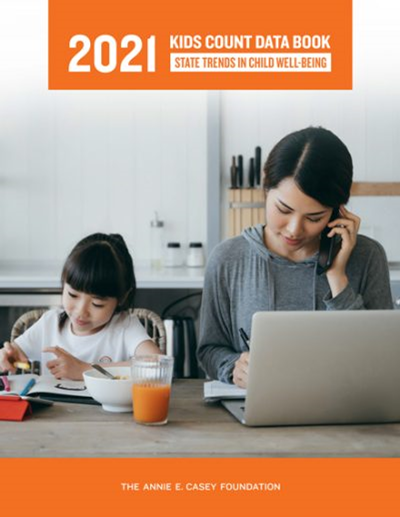SUMMARY
The 32nd edition of the Annie E. Casey Foundation’s KIDS COUNT® Data Book describes how children across the United States were faring before — and during — the coronavirus pandemic.
This year’s publication continues to deliver the Foundation’s annual state rankings and the latest available data on child well-being. It identifies multiyear trends — comparing statistics from 2010 to 2019. In addition, the report shares data on how families endured throughout the pandemic.
HOW KIDS AND FAMILIES HAVE WEATHERED THE PANDEMIC
Every child needs food, health care and safe and stable housing. Millions of households with children already lacked these necessities before the pandemic, and this economic and public health catastrophe brought millions more face-to-face with challenges ranging from lost health insurance and bare pantries to the threat of homelessness due to eviction or foreclosure.
An additional area of concern: Students are completing a second academic year disrupted by COVID-19, undermining academic performance and altering post-high school plans.
RECOMMENDATIONS FOR RECOVERY
The nation will not recover from this crisis without innovative public policy. Several of the Foundation’s federal policy recommendations have already been enacted through the 2020 CARES Act and with 2021’s American Rescue Plan. Of particular note is the historic expansion of the federal child tax credit, which is expected to cut the child poverty rate by more than half. Unfortunately, the expansion is currently slated for only one year.
To continue progress already made on recovery, the Foundation recommends: making the expansion of the federal child tax credit permanent; strengthening state and local policies affecting kids and families; and prioritizing racial and ethnic equity in policymaking.
STATE RANKINGS
This year, New England states hold two of the top three spots for overall child well-being. Massachusetts ranks first, followed by New Hampshire and Minnesota. Louisiana (48th), Mississippi (49th) and New Mexico (50th) are the three lowest-ranked states.
States in Appalachia, as well as the Southeast and Southwest — where families have the lowest levels of household income — populate the bottom of the overall rankings. In fact, except for Alaska, the 17 lowest-ranked states are in these regions.
RACIAL INEQUITIES IN CHILD WELL-BEING
Despite gains for children of all races and income levels during the reporting period, the nation’s racial inequities remain deep, systemic and stubbornly persistent. Data suggest that we as a nation fail to provide children of color with the opportunities and support they need to thrive. States are failing to dismantle barriers that African American, American Indian and Latino children especially encounter. As a result, nearly all index measures show that children experience disparate outcomes in spite of their potential.
In 14 states, the District of Columbia and Puerto Rico, kids of color were the majority of the child population in 2019. The future success of our nation depends on our ability to ensure all children have the chance to be successful.

